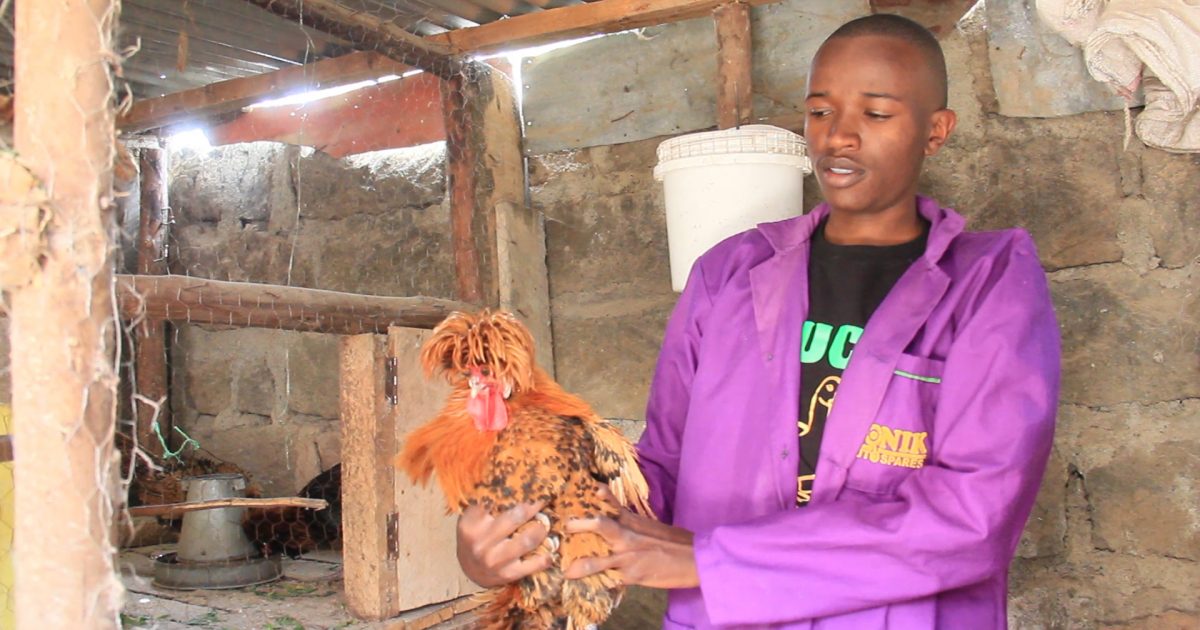When 21-year-old Brian Kamira ventured into ornamental bird keeping, it was purely a hobby but nonetheless, it has turned out to be a great and profitable venture for him.
Mostly kept for their aesthetic allure, a single bird at his Kamira Birds Farm, in Barnabas Estate on the outskirts of Nakuru Town fetches as much as Shs30,000.

The second-year student at the Dairy Training Institute in Naivasha specifically keeps Silkie Bantam chicken, Polish Bantam chicken, Budgerigars and guinea fowls. Kamira also rears various species of geese, parrots, ducks, pigeons and turkeys.
Unlike other chicken breeds, bantams double up as pets and attract significantly higher prices.
At Kamira Birds farm, a mature bantam chicken and cock of the Silkie breed costs Sh7,000 and Sh9,500 respectively, while a chick sells for Sh1,400.
“I sell a fertilized bantam chicken egg for Sh300. Their demand is high while the supply is low, so they fetch good prices in the market,” he says.
The breed has unusual characteristics which make them popular ornamental birds such as feathers that feel like fur, black skin, blue earlobes and five toes on each foot whereas most chickens have four,” adds the breeder.
Initially, Kamira started the enterprise by rearing pigeons before diversifying into the other ornamental species after sourcing for parent stock from Mombasa, Tanzania mainland, Zanzibar Island and Wakiso District in Uganda.
To kick off, he spent Sh27,000 saved from sale of pigeons to purchase his first pair of Silkie bantams, put up structures at his farm and secured the necessary permits from the Kenya Wildlife Society (KWS).
Before issuing a license to keep or rear ornamental birds, KWS officials have to visit one’s farm to ascertain its suitability to raise the birds. An annual fee of Sh1,500 is also charged for the initial species of birds and Sh500 for each species introduced subsequently.
“I was determined to succeed. Many of my age mates have embraced poultry keeping because of the quick returns. But I opted for ornamental ones that fetch higher profits,” says Kamira.
“I researched online on breeding, feeding and management and took a leap of faith. Gradually, the numbers increased and so did my clients. Most people buy them for aesthetic purposes,” he says.
Kamira, a breeder for three years now, sells one parrot at Sh30, 000 while a pair goes for sh40,000. Budgerigars, which are currently out of stock, cost Sh4,000 per bird while the guinea fowl fetches from Sh1000 to Sh1500 depending on the weight of the bird.
He says parrots are intelligent, musical, colourful and beautiful, traits that make them attractive. Of all birds in the family, the grey parrot is the most intelligent and expensive. The breeder states the grey parrots learn human language, music tones and other sounds faster than other types.
The breeder sells a mature turkey which weighs averagely 7 kilograms for Sh8,000 per bird, one day to one week old Polish Bantam chick costs Sh1,000 while those which have attained three to four months fetch Sh2,500. This is considerably impressive returns for a poultry farmer taking into account that a day-old broiler sells at Sh100 on average.
His greatest inspiration is stable markets and growing demand for ornamental birds.
“Though I market my birds through social media, I have a number of regular clients mostly from Coastal and Nairobi regions. They always come for the birds here. Few people rear ornamental birds despite the ready market,” he points out.
Unlike chicken, ornamental birds are majorly resilient to diseases and do not require special diets, greatly reducing the costs involved in keeping them.
Kamira says though ordinary poultry and ornamental birds have the same food consumption needs; ornamental birds have more returns.
To bolster his earnings, Kamira has also acquired an incubator and a generator for egg hatching.
“My seed capital was small, but with more orders coming, I had more money which I used to buy an incubator and a generator. My starting capital was sh27,000 but now I can say my business is worth some hundreds of thousands of shillings,” the farmer says.
His business having broken even, Kamira says he comfortably pays for his fees and upkeep at the Dairy Institute where he is pursuing a Diploma in Dairy Technology and saves every extra coin he makes.
Through research and practical experience, the farmer has acquired critical skills needed to run poultry keeping ventures.
In breeding ornamental birds, he says it is very vital to establish health of breeders and age of eggs and age of breeders.
“Storage of eggs should be done with maximum care. In the incubator, the temperatures should take into account requirements of a specific species. Eggs with a maximum of ten days after being laid are preferred. Before you put the eggs in the incubator, look out for those that have defects like cracks and dispose them off. Disinfect the good ones and the machines to ensure the chicks do not contract infections,” Kamira advises.
Immediately the chicks are brought out of the hatchery, Kamira embarks on a vaccination schedule first against Newcastle when chicks are five days old and Gumboro when they are ten days. At 21 days the chicks are administered with a second dose of Newcastle vaccine.
For farmers who have acquired incubators, Kamira advises that they must have a backup power plan like a generator.
“They should have generators because in the event of a blackout, the outcome can be disastrous,” he adds.
By Anne Mwale and Dennis Rasto




